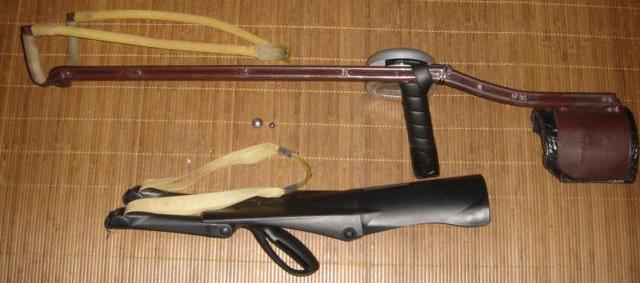

A lot of effort has been put into constructing powerful slingshots. For whatever reason, people feel attracted to power. Some, like hunters or long-range shooters need it, but most of us don't have a real need for delivering a heavy projectile at high speed. But then, we also have no need for nice cars, colorful clothes, good books and tasty food. It is part of human nature to want such things.
The following facts are taken from both from real-life observation and calculations, some of them can be seen in my "science" article.. But this time, i try to exclude all formulas, and only give you the results, and advice how to use it.
Lets assume two persons want to create a slingshot. The first one is a target shooter. He needs acertain amount of power to hit his target properly, and wants to keep the pull weight as low as possible to keep accuracy at maximum level. The second shooter is a hunter. He wants maximum power, but must keep pull weight below some reasonable value to remain accurate enough.
Both persons seem have different goals - but in fact, they have the same: They want the most "bang for the buck", that is, the most power for the pull weight. And this is what we call the "performance". It is no fixed value, as it will change with the ammunition you use, the pull length of the shooter etc.
The reason why I'm telling you about performance is to hand the bad message over to you: The powerful slingshot has always a lower performance than its weak brother. Don't get me wrong, there are a lot of ways to increase power without sacrificing performance - but these all have their costs and are, ultimately, not increasing power, but increasing performance for the same pull weight. In short: If you have to slingshots with similar design, use similar ammo etc, the one with the weaker bands will have a better performance, because its band weight is lower in respect to ammo weight, the bands have more outer surface, and many other reasons.
And this is not just theory. Most people are surprised by the power of a little small-banded slingshot, while a really "powerful" slingshot is still within limits that are hard to break.
Let us take a slingshot and replace the bands with two pieces of strong metal wire. We can pull as much as we want, the projectile will not leave the pouch. Why?
The reason is pull length. The projectile get accelerated over a certain distance with the force that the rubber has at each point of the accelerating way. The pull force is just the force of the first "point" of this acceleration way. The metal wire slingshot has almost no acceleration way and therefore, the projectile doesn't fly away.
If you use a rubber band instead, you get a long acceleration way, and the pellet flies away. And now the good news: If you pull one centimeter of rubber over a distance of five centimeter, or ten centimeters of rubber over a distance of 50 centimeter does not matter - in the end, you will have the same pull force, but as you can imagine, the projectile of the 50-centimeter-slingshot is more faster, as it had a much longer acceleration way.
What does that mean?
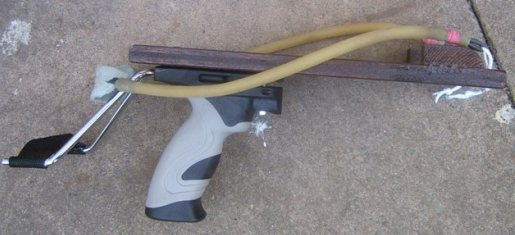
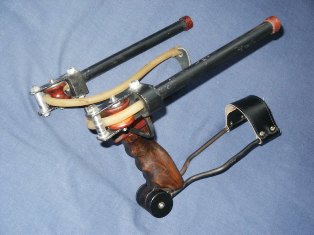
The longer your pull length, the more power you get, with the same pull weight. Which also means you get more performance. You can increase the pull length by extending the slingshot fork. Velocity will greatly improve, but the slingshot gets much bulkier and heavier. And this is a big disadvantage, as the compact design is one of slingshot's most outstanding features. Another disadvantage is the leverage of the slingshot, it wants to "turn around" in your hand, so a wristbrace is necessary to stabilize it. You can also "kink" the acceleration way by means of two pulleys. Such a "ComBow" slingshot is shorter and has less leverage, but is quite complex and even heavier. Another disadvantage is that higher speed means lower band lifespan.
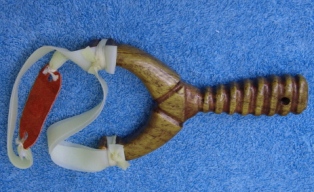
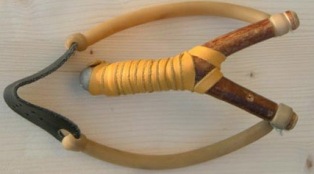
Now, let us take a look at the bands. Of course, a more powerful band means more power during the acceleration way, and this means better acceleration, at the cost of higher pull weight, so you arent as accurate and your hands get tired faster. But lets take a weak band and a strong band of the same material and let them snap. Both will be equally fast. Why? Simply because the big band is heavier. Double the pull force meand double the band weight, so both bands are the same. A powerful band has the same speed as a weak one when shot empty, but it doesn't care as much about the projectile weight as the weak band. And this is the great difference between extending pull length and using more powerful bands: The more you extend pull, the higher the velocity - no matter what projectile. But the strong bands only make sense if you use heavy ammo -and the lower accuracy is a big disadvantage. If you miss, no one cares how powerful your shot was. And, as we will learn later, the smaller bands are always performing better because they have a lower inner friction.
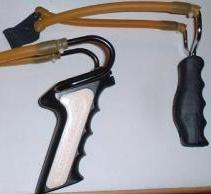
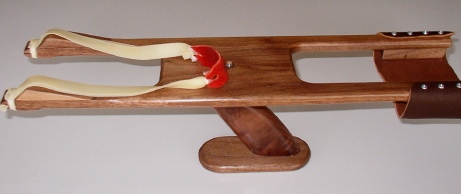
Now we can construct two extremes: A slingshot without fork extension, with heavy bands and a slingshot with large fork extension and weak bands. The first model is what we call a "heavy hitter". Its advantages are the compact design, high lifespan of the bands and the pouch weight is not too important. Disadvantages are high pull weight - and therefore, lower accuracy and the need for some muscles to compensate - and it needs heavy ammunition to benefit from the powerful bands.
The second slingshot has a large fork extension and weak bands. Its low pull makes it accurate and easy to shoot, and you can use lighter projectiles and propel them at high velocities, and with a flat trajectory bow. But it is bulky and heavy, the bands don't last as long and it is more difficult to construct.
The difference between these slingshots is like a javelin-thrower who can achieve high speed with his javelin, and a strong hammer thrower who has lower speed, but throws a much heavier missile.
A note for the hunters: A rifle, with its high velocities, cannot be compared to a slingshot. At the same energy, a faster and lighter rifle bullet makes more damage than a heavy, slower one. this also true with slingshots, but to a far smaller extent.
Now you know the basics about fork extension and pull length. But how long shall the rubber be in relation to the pull length? Let us take a look at the pull length and pull force:
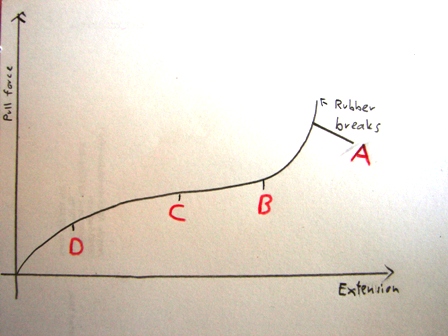
A perfect rubber would have a straight horizontal line. that means, the pull force does not increase during pulling (It would be even better if it would get smaller, but such a rubber will never exist), so, at maximum pulllength, we want to be somewhere where the graph is as flat as possible.. And a second thing is important: The shorter the rubber, the less weight we have, the better the performance. That means, we want to be at a point where the pull force curve is not too steep, but want to be rather on the right sige of the graph, where we need less rubber to get the same pull length.
If you read the text above, you saw that pull weight is nothing without pull length. And in the end of the curve (after point "B") we get a lot of pull weight for a few extra inches. That means, we get a little extra power for a lot of extra pull - a bad tradeoff. We should have better taken stronger bands which are a little longer, to get more power for less aditional pull weight. And the second extreme: Someone takes very strong bands. He cannot pull then correctly, so he keeps them too long (point C or D). The heavy bands have a lower pull that way, but the high mass and low pull length makes them ineffective, and he would get more power with weaker bands which are shorter!
To get the best performance, you'll try to stay somewhere around point "B", where you have a lot of pull, yet not too much pull weight.
The longer you stretch the bands, the lesser their lifespan. Someone who wants his bands to live longer will go to point "C". He has a lower performance, but the bands are less stressed. For example, my last tournament slingshot had quite long bands. I traded some of performance for a higher security that they don't break in the middle of the tournament.
Many commercial models have too long bands when they come from the factory, and most uneducated shooters don't shorten them and linger around point "D", so they have ineffective slingshots with low performance. Add the far too small 1/4" steel shot most people use and the heavy leather pouches that are employed by some companies, and you don't have to wonder why many people regard slingshots as toys.
The shape of the bands does also affect performance. Generally, a higher surface means higher performance (and lower lifespan). A very thin, flat band would be perfect, but you cannot make the bands as broad as you want, so you must cut them in pieces and use double or even triple straps on each side. Such a multi-band asembly with flat bands has the highest performance, but it can obstruct the view and some people don't like to have multiple straps on each side.
Now, we see why stronger bands have always a lower performance if the shape remains the same: The relation of surface to volume gets worse:
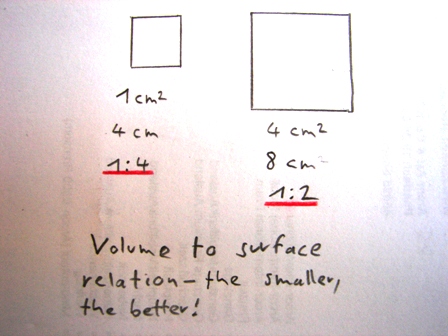
The only way to counter this is to make the bands very broad or take multiple bands on each side, but both methods are only practical within reasonable limits.

Almost every high-performance slingshot today uses tapered bands. Tapered bands get smaller towards the pouch. The rubber part towards the fork gets not accelerated at all, while the part on the pouch gets full accelerated. So, you put large parts of the mass towards the fork and voilá, you have a much better performance. Tapered tubular bands (namely the Trumark RR-t) can even compete with flat bands, performance-wise. Another advantage is that the bands break at their weakest point, on the pouch, and will never snap into your face. Disadvantage is the smaller lifespan (not much with normal bands, very much with extreme tapered ones), and it is more difficult to make such bands.
As I told above, heavy ammo is absolutely necessary for powerful slingshots, especially for the ones with heavy bands. If you can't get hold of heavy ammo, you don't need extreme bands. I know of people who use 11mm strong bands on their slingshot and shoot marbles and 1/4" steel shot. That's like using a 15-ton truck to transport a basket of fruits. Next, the pouch: If the pouch weights one gram less, the projectile can weight one gram more and still have the same speed. Sounds good? Is good. Make the pouch as light as possible. And last, don't get carried away with all that power stuff. You can create very big slingshots with huge extensions, buy expensive ammo and attach extemely tapered, extra strong bands that break after 20 shots. And you'll recognize that such a slingshot is nothing to take in the woods when hiking - and if you're out in the woods, it doesn't matter what slingshots are waiting at home. It may be a -rather scientifical- challenge to make a very powerful slingshot, but don't expect to have more fun with it than with a good old classic fork that fits in your pocket and doesn't need replacement bands every two weeks. Before construction, ask yourself where you're going to use that slingshot, and how far you have to carry it.
If you understood the text above, you have enough knowledge to make a slingshot that one would consider as good, or to tune up your existing model. So, use your knowledge, and make something - I wish you lots of fun, and am happy about every photo you send me :-)